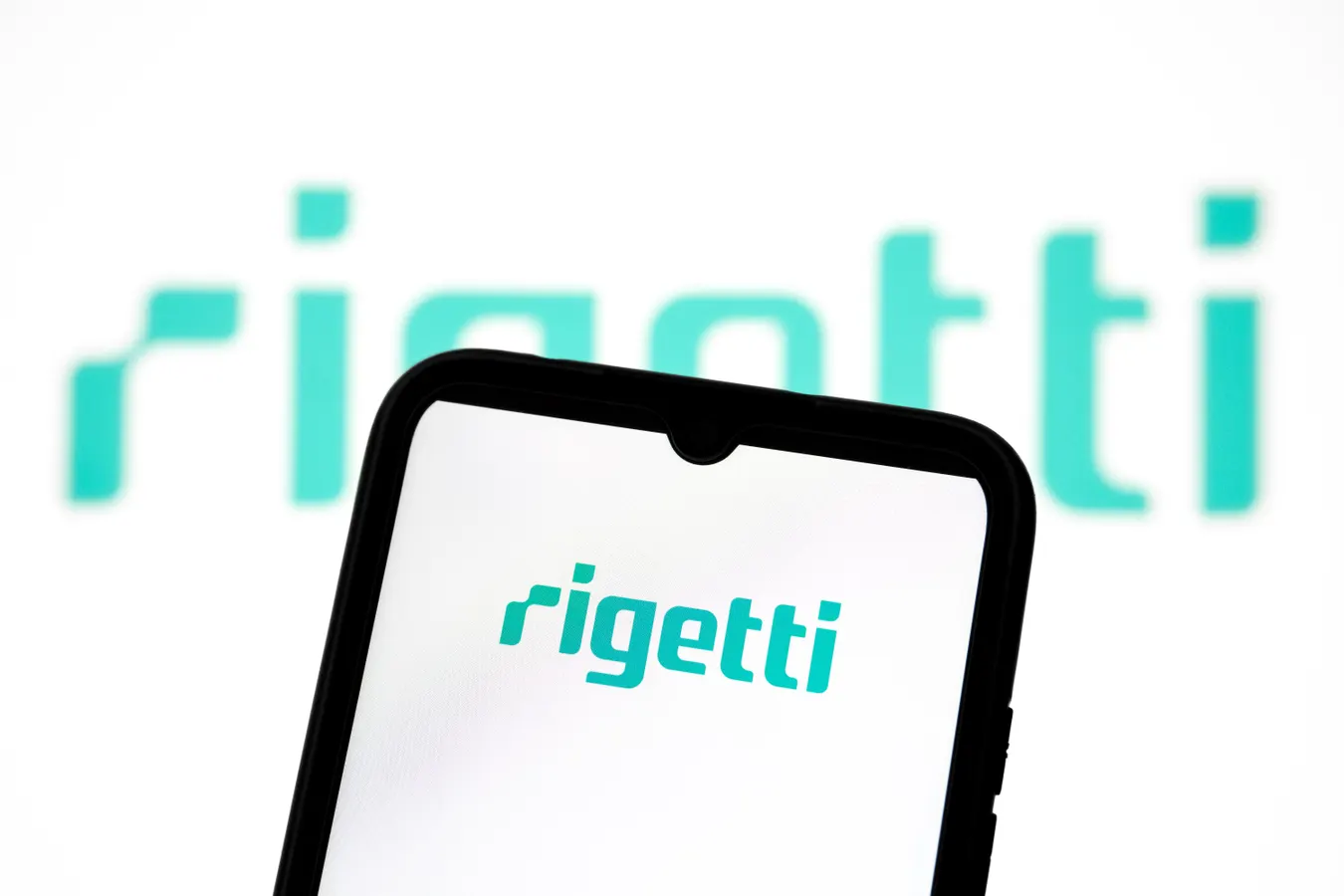By Contributor,Nikolas Kokovlis,Trefis Team
Copyright forbes

The Rigetti Computing logo appears on a smartphone screen and as the background on a laptop computer screen in this photo illustration in Athens, Greece, on September 25, 2025. (Photo by Nikolas Kokovlis/NurPhoto via Getty Images)
NurPhoto via Getty Images
Rigetti Computing’s stock has risen a robust 135% within a month, fueled by various factors that signify the company’s shift from solely research and development to approaching a commercial reality. The quantum computing industry has generally experienced a boom, with Rigetti outperforming its competitors. Here is what has been driving the momentum:
On September 30, Rigetti announced that it had secured purchase orders for two Novera quantum computing systems, worth roughly $5.7 million.
On September 18, Rigetti received a $5.8 million, three-year contract from the U.S. Air Force Research Laboratory to enhance superconducting quantum networking in collaboration with QphoX. These orders indicate a movement towards commercialization.
In September 2025, Rigetti signed a Memorandum of Understanding (MOU) with India’s Centre for Development of Advanced Computing (CDAC) to investigate the co-development of hybrid quantum computing systems.
In August 2025, Rigetti made its latest 36-qubit system, Cepheus-1-36Q, which has a 99.5% fidelity, available on its cloud platform.
However, here’s the pivotal question: Is there still significant upside potential in RGTI stock following its substantial surge, and if so, why? The concise answer is yes. We will explore this further in the following sections. That being said, if you’re interested in an upside with reduced volatility compared to holding a single stock, consider the High Quality Portfolio. It has consistently outperformed its benchmark—a combination of the S&P 500, Russell, and S&P MidCap indexes—and has generated returns exceeding 91% since its inception. Why is this the case? In general, HQ Portfolio stocks have delivered better returns with lower risk compared to the benchmark index; they present less of a roller-coaster experience, as evidenced by the HQ Portfolio performance metrics. Additionally, see – How Oracle Stock Delivered $163B To Investors
The 10x Upside Case: Why the Thesis Remains Intact
We discussed a 10x upside potential for RGTI stock a few months ago, and the stock has already increased by 2x since that time. But here’s the reality—the fundamental drivers remain unchanged. In fact, they have become stronger. Let’s delve into why Rigetti may still have considerable growth potential.
The Modular Architecture Advantage
In contrast to competitors utilizing monolithic processors, Rigetti’s chiplet model effectively tackles the primary scaling challenge in quantum computing. Conventional quantum computers find it difficult to scale because increasing qubit counts on a single chip vastly heighten complexity and error rates. What is Rigetti’s solution? Divide it into smaller, modular chips that communicate with one another.
The capacity to sustain a 99.5% fidelity while scaling via connected modules positions them as a prominent player in the quest for practical, large-scale quantum systems. This is not merely theoretical—their 36-qubit Cepheus-1-36Q system, constructed from four interconnected 9-qubit chips, proves that high-fidelity quantum operations can be upheld even across chip boundaries. This modular approach enhances system reliability, simplifies manufacturing, and supports real-world performance in ways that monolithic designs simply cannot replicate.
MORE FOR YOU
Strategic Manufacturing Partnership And Improving Cash Position
The $100 million commitment from Rigetti and Quanta over five years, along with Quanta’s additional $35 million investment, offers both manufacturing expertise and capital for large-scale commercialization. This is not just funding—it signifies validation from a manufacturing titan that recognizes commercial viability in Rigetti’s technology. Quanta does not make these pledges lightly; they envision a pathway to production levels that justify their investment. Additionally, Rigetti finalized a $350 million at-the-market equity offering in June 2025, which has bolstered its cash reserves. Rigetti currently holds $426 million in cash with minimal debt.
Government Validation and Revenue Stability
DARPA’s QBI program selection and consortium leadership signify credibility and result in stable revenue streams for utility-scale quantum development by 2033. Government contracts generate reliable revenue, funding R&D as the commercial market evolves. The Air Force Research Laboratory contract exemplifies this validation—the U.S. government placing its trust in Rigetti’s approach to quantum networking.
Perfect Timing for Commercial Market Transition
Here’s where it becomes particularly compelling. The quantum computing market is at a pivotal moment. The industry generated between $650 million and $750 million in revenue in 2024 and is forecasted to exceed $1 billion in 2025. The global quantum computing market is expected to grow from $1.6 billion in 2025 to $7.3 billion by 2030—that’s a compound annual growth rate of over 35%, according to a McKinsey & Company report.
As quantum computing shifts from research to commercial applications, Rigetti’s advanced chiplet architecture and cloud-based services position it to seize an outsized portion of market share. They are not merely entering a growing market; they are uniquely equipped with technology that addresses the scaling problem that others are grappling with while employing varied methodologies to solve the issue.
The Reality Check: Risks You Need to Understand
In summary, Rigetti Computing is at the forefront of quantum stocks, attracting increasing investor interest, and the rally could persist at even higher levels in the coming years. However, let’s be frank—this sector requires caution.
Commercial application is still years away. While 2026-2030 appears promising for practical applications, mainstream, large-scale quantum computing is likely still some years off. You are investing in a future that may take longer to realize than the current enthusiasm implies.
The larger technology giants such as IBM, Google, Microsoft, and Honeywell are heavily investing in quantum computing and obviously have significantly deeper financial resources. IBM and Google have made substantial progress, and these companies can outspend Rigetti by large margins. The real question is not whether they have more resources, but whether Rigetti’s architectural advantage can lead to market leadership before these giants catch up.
Putting money into a single stock without thorough analysis can be perilous. Consider the Trefis Reinforced Value (RV) Portfolio, which has outperformed its all-cap stocks benchmark (a combination of the S&P 500, S&P mid-cap, and Russell 2000 benchmark indices) to deliver strong returns for investors. Why is this so? The quarterly rebalanced blend of large-, mid-, and small-cap RV Portfolio stocks have provided a responsive way to capitalize on favorable market conditions while minimizing losses during market downturns, as detailed in RV Portfolio performance metrics.
There are additional risks to consider, which we’ve captured in our separate analysis on RGTI stock downside potential. The volatility associated with RGTI stock is characteristic of speculative growth investing. The same momentum that could lead to 2,000% gains can vanish just as rapidly if sentiments change or technical milestones are not achieved.
The Bottom Line
Rigetti offers a high-risk, high-reward investment at a crucial moment for quantum computing, characterized by the company’s genuinely impactful modular architecture and supportive government and manufacturing partnerships that foster multiple growth pathways. While the technological differentiation is strong and the timing in the market is favorable, this investment is only for those who can tolerate extreme volatility, as the company is confronted with competition from tech giants, dependence on evolving technology, and the considerable risk tied to necessitating near-perfect execution to realize its substantial upside potential—potentially a 10x return.
Editorial StandardsReprints & Permissions



